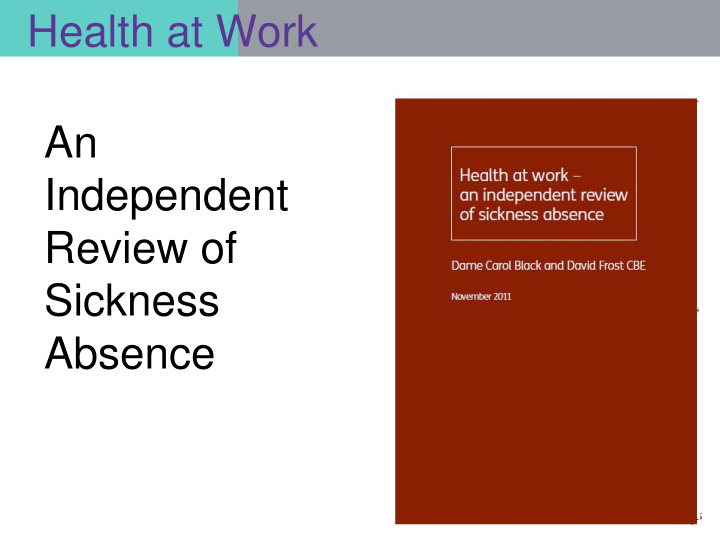



Health at Work An Independent Review of Sickness Absence
Terms of Reference • to explore how the current sickness absence system could be changed to help people stay in work, reduce costs and contribute to economic growth • to examine whether the balance of these costs are appropriately shared between the state, individuals and employers • to make tangible recommendations for system change
The Review was established to consider overall sickness absence system State (Worklessness benefits; foregone taxes; extra healthcare) Individuals Employers (Loss of income; (SSP/OSP; costs of staff emotional and physical turnover; time spend costs of ill-health) managing absence; OH where offered) Cost of sickness absence to economy c £15bn
The current journey There are too few drivers in the journey keeping people in work. 28 weeks 39 weeks ESA benefit and support JSA Claim to Claim to benefit and support Work Employment Work Employment Sickness Work Capability Support Capability Support absence Assessment Allowance Assessment Allowance Work (ESA) (ESA) Inactivity The State’s main interventions are focused on the Management of sickness absence by employers is after job-loss period. inconsistent. Lower paid, lower skilled employees Huge delays in assessing benefit claimants’ work and those from smaller firms have less support. capability. 85% of fit notes sign people off completely unfit. 140,000 ESA claimants come straight from work without a period of support from their employer.
Our recommendations address problems throughout the sickness absence journey Tax relief, public sector recommendations – managing absence in employment Job Brokering - helping people move jobs WORK Short-term Long-term 24m absence absence 11m 1m IAS - reducing flows into long-term sickness (2.9m off sick with GP’s certificate) 1.9m 0.5m 0.5m 0 8 days 4 wks 8wks 28 wks ESA reforms - ESA reforms - reducing flows on to ESA reducing flows on to ESA from work from sickness ESA (140k) (110k)
Our main recommendations In employment • Introduction of Independent Assessment Service (IAS) • Tax relief on medical interventions/VR (for basic rate tax- payers) • Abolition of PTS • Recommendations to reduce public sector absence (incl. review OSP) • Job brokering service for long-term sickness absence cases The benefits system • Abolish the 13-week assessment phase for ESA • Change Jobcentre Plus’ claims policies to direct more people who are fit for work straight to JSA
New Journey - details
Flows between work, absence and ESA before and after our recommendations 12-15 months after ESA claim 120,000 (140,000) 30,000 (110,000) Economically Employees active 140,000 (340,000) 24.0m Short time Long-term Claim to sickness sickness Employment absence absence Support Allowance (ESA) 350,000 Self- (650,000) 60,000 (80,000) employed 3.5m Economically Out of inactive 210,000 140,000 (320,000) work/ (310,000) inactive 11.4m Figures may not sum due to rounding.
Overall savings – impact of measures (£m pa) Government Employers Economy Independent Assessment -10 +100 +150 Service Job brokering Up to +300 Up to +50 Up to +800 ESA system +100 +300 Tax incentives -150 +250 +100 Percentage Threshold +50 Up to -50* Scheme Total Up to +300 Up to +400 Up to +1,400 * this offset comes from the associated reduction in admin burdens
Conclusions – what does our proposed new system achieve? • A swifter and more sensible journey from work, to support and back again; • Complex cases will be assessed more quickly, in work and in the benefits system; • Individuals who need financial support will get it sooner; • Employers who invest in inventions will be encouraged, not penalised; • The State will support job search earlier in the journey; • Overall savings for employers and tax-payers and an increase in economic output.
Recommend
More recommend